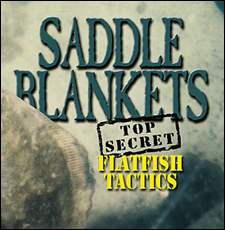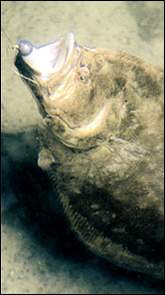|
 For unusually large flatfish, it pays to employ some unusual tactics in places you wouldn't usually suspect. Here, from our resident flounder fishing fanatic, are some proven off-the-wall techniques for on-the-wall trophies.
For unusually large flatfish, it pays to employ some unusual tactics in places you wouldn't usually suspect. Here, from our resident flounder fishing fanatic, are some proven off-the-wall techniques for on-the-wall trophies.
By Chester Moore, Jr.
Page 2
If you're having a hard time finding holds, you can try positioning the boat on the edge of the drop-off and using the same technique. If you have a trolling motor (and every serious saltwater boater should, for this reason and more), set it on "low" and let the bait drag the bottom. If you don't own a trolling motor, make long casts parallel to the drop-off so you can cover more ground.
 Jetties specifically, jetty channels are other deep-water areas that frequently hold big flatfish. Since jetties serve as sort of a "flounder funnel" between the bay and Gulf, the action can be hot right up until December, when the flounder migration to Gulf breeding grounds is complete. Jetties specifically, jetty channels are other deep-water areas that frequently hold big flatfish. Since jetties serve as sort of a "flounder funnel" between the bay and Gulf, the action can be hot right up until December, when the flounder migration to Gulf breeding grounds is complete.
David Geautreaux of Beaumont frequently fishes for flounder at boat cuts of jetties during this productive time frame, and says some of the biggest fish can be caught there.
"You'd be surprised," Geautreaux says, "at how many flounder can be caught at the jetties if you use the right tactics."
He uses a live mud minnow (a.k.a. "Gulf killifish") and 1-ounce egg sinker rigged on a swivel attached to a 20-pound monofilament shock leader, and he hooks the bait through its lips.
"When you fish some of the areas that I fish, you need heavy stuff," Geautreaux advises. "There are lots of rocks and stuff in these areas, and I would hate to miss a saddleblanket flounder because I was under-rigged. Don't be afraid to use heavy line.
"I like to anchor around the boat cut and thoroughly work a small area," Geautreaux explains. "Making a good, long cast and dragging the bait all the way to the boat is critically important. I have caught many a flounder right at the boat a spot that many anglers tend to overlook."
Something to keep in mind when fishing around these current-laden cuts: Fish with your bait working against the current. By doing so you can control the movement of the bait instead of the current doing it for you.
Other good areas for trophy-class flounder are the vast oyster reefs that cover much of our bay systems. Flounder fishing in these shell-studded locales involves a totally different method than in ship channels or jetty areas. Oyster reefs have pretty much the same depth throughout, and as such, drifting while fishing a bait on the bottom is the prime way to locate the fish.
This method is all about the terminal rig. This rig is what I call a "breakaway rig," because it is designed to allow the angler to break off the weight rather than lose the entire rig.
To make a breakaway rig, take a barrel swivel and attach a 24-inch, 10-pound-test monofilament leader connected to a 1-ounce round weight on one end and a 12-inch, 25-pound test leader fitted with a hook on the other.
Using 20-pound or better test line allows the angler to drift over the oyster bed to potentially encounter flounder while simultaneously giving him the ability to break off the weight if it gets hung up, rather than lose the whole thing.
When I use this method I slowly raise and lower my rod tip to give the rig a hopping action. Live bait is usually best, but I've also had success with plastics. Catch-Em Lures has a bait called the Sabine Snake which imitates the sand eels found on reefs (which, by the way, is a favorite prey item of reef-loving flounder). I first got turned on to the lure while speckled trout fishing, but have found it to be very effective for flounder as well. The Norton Sand Eel and Berkley Power Sandworm are other good options.
Another piece of equipment that is a big help to drifting anglers is a wind or drift sock, one of the more notable being the "Drifter" made by NuMark Manufacturing. The Drifter is a parachute-like bag that is put into the water and used to slow down your drift, and it can mean the difference between catching fish and not catching fish especially if the current is extra-strong. I use a homemade drift sock, but again, there are several quality commercial drift socks.
Don't get the idea that the standard flounder habitats of marshy cuts and shorelines don't harbor big flounder. They do. But the other areas receive far less intelligent fishing pressure than cuts and sloughs, and may well be legitimate untapped hotspots in your chosen bay system.
Veteran flounder specialist Capt. Skip James (409-886-5341) advises anglers to look to the main points of a bay in order to target bigger flounder during fall.
"In my experience," James says, "the biggest fish start exiting the bay first during their annual fall migration. After a couple of cool snaps they start to exit the marshes and stage on the big points. In Sabine Lake, where I fish, many big flounder stack up at East Pass, where a river and several major bayous meet the bay. This is a prime place for flounder to stack up and get fat on baitfish before they make their Exodus into the Gulf."
James advises anglers to begin their fall mornings fishing out away from the big points, slowly working toward the bank as the sun gets toward the sky. "For some reason," he says, "these fish tend to start off deeper and move toward the bank as the day wears on."
James says that anyone's favorite flounder bait will work with this method, but he sticks with his 1/4-ounce white Mister Twister jig tipped with shrimp.
"If it ain't broke don't fix it if you know what I mean," he comments. "This combo has proven itself to me time and time again."
When the flounder begin their fall run you can stick with the tried-and-true methods or gamble with some of these hardcore, big-fish-specific techniques. You'll probably catch fish either way, but which would you rather have a stringer full of eating-sized fish, or something that resembles a juvenile halibut?
It's your choice.
# # # #
page 1 / page 2
| 




